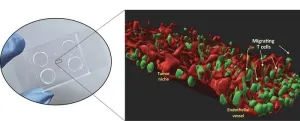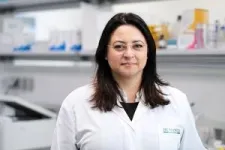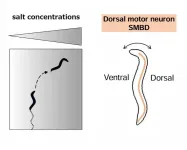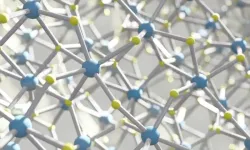(Press-News.org)
Milano, January 22nd 2024 – It is only a few centimeters in size and can be held between two fingers, but in the micro-channels carved inside it, it’s hidden a three-dimensional and highly faithful model of a biliary tract cancer called cholangiocarcinoma, complete with its tumor microenvironment. This 3D model is built starting from a sample of patient’s cancer cells and thus it represents a patient-specific "organ-on-chip": a technology made possible only through a multidisciplinary approach that merges biomedicine, physics and engineering.
The innovative prototype is the result of the collaboration between Ana Lleo De Nalda, full professor at Humanitas University and head of the Hepatobiliary Immunopathology Laboratory at Humanitas Research Hospital, and Marco Rasponi, associate professor at Politecnico di Milano and head of the Laboratory of Microfluidics and Biomimetic Microsystems. The study was made possible thanks to the collaboration with the group of Prof. Guido Torzilli, Director of the Department of General Surgery and head of the Hepatobiliary Surgery Unit of the IRCCS Istituto Clinico Humanitas.
"The ultimate goal of the device is to accelerate research on cholangiocarcinoma by providing a new laboratory model that better mimics what we observe in patients. At the same time, it will help advancing precision medicine, since it could be potentially used as a personalized drug-testing platform, helping predict patients’ response to therapies," say Ana Lleo and Marco Rasponi.
The study was funded by AIRC - the Italian Foundation for Cancer Research, and was published in the Journal of Hepatology Reports.
Cholangiocarcinoma: a rare and aggressive cancer
Cholangiocarcinoma is a rare cancer of the liver (it affects about 5,500 people in Italy alone, each year) and it derives from a malignant transformation of cholangiocytes, the cells lining the biliary tract.
Unfortunately, the disease is often diagnosed at an advanced stage, because patients show very few symptoms. This is also why treatments are often ineffective: at the time of diagnosis, only 10-30% of patients are eligible to undergo surgical removal of the tumor.
"Precisely because of the reduced therapeutic options and high mortality of cholangiocarcinoma, we need new in vitro models that can recapitulate the characteristics of the disease and in particular the interaction between tumor cells and cells of the immune system, which play a key role in its progression and response to drugs," explains Ana Lleo.
Now, for the first time, researchers from Humanitas and Politecnico di Milano developed a personalized 3D model of the disease.
A 3D platform for advancing research and personalized medicine
"It is a microfluidic chip a few centimeters in size. Inside the device, in the micrometer channels realized using advanced photolithographic techniques, we seeded cancer cells sampled from patients affected by cholangiocarcinoma. The cells successfully reproduced the tumor architecture in vitro,” explains Marco Rasponi.
To add complexity to the model and improve its reliability, researchers seeded also fibroblasts (cells forming the connective tissue), T lymphocytes (a type of immune cells) and endothelial cells (cells lining the blood vessels that feed the cancer and screen it from immune responses).
In a series of experiments, the team of researchers demonstrated that the device faithfully recapitulates what we observe in individual patients, both in terms of T-cell activation, that correlates with tumor infiltration, and in terms of therapeutic response to different drugs, based on the characteristics of cancer recurrence.
"The next steps will be to further optimize and improve the device, both as a research model and as a personalized drug-testing platform: we want to add cells of innate immune system, such as macrophages, which play an important role in tumor progression, and introduce micro-pumps that can mimic blood flow and vascularization. We also need to test it on larger groups of patients, to confirm its ability to recapitulate the phenomena we observe in the clinical setting," conclude Ana Lleo and Marco Rasponi.
END
More than 11 million people in the United States take anticoagulation or antiplatelet medications, such as heparin or aspirin, to treat serious conditions like heart attack and stroke. However, these medications also put patients at risk of life-threatening bleeding in the case of injury or during surgery. To improve strategies for reducing blood loss, a team led by investigators from Brigham and Women’s Hospital, a founding member of the Mass General Brigham healthcare system, developed a porous material that maximizes blood absorption and effectively activates clotting mechanisms, even in patients on anticoagulation or ...
New biomarkers with improved diagnostic performance for early detection of lupus nephritis have been discovered in the University of Houston lab of Chandra Mohan, a pioneer in lupus research. Early identification of renal involvement in lupus and prompt treatment are essential in reducing the pain, suffering and eventual mortality it causes.
Systemic Lupus Erythematosus (SLE), commonly called lupus, is an autoimmune disease that occurs when the body attacks its own tissues and organs. Inflammation from the disease can impact many different parts of the body including joints, skin, kidneys, blood cells, brain and heart. Lupus nephritis is one ...
Motion capture technology has applications in a wide range of fields, including entertainment, medicine, and sports, to name a few. But what if the measurements these systems were based on were rooted in social practices and biased assumptions, leading to errors that become ingrained over time?
This question is at the heart of new research co-authored by Mona Sloane, an assistant professor of data science and media studies at the University of Virginia.
Sloane and her co-authors — Abigal Jacobs, an assistant ...
Genetic changes or mutations can cause hereditary kidney disease, which can eventually lead to dialysis or the need for kidney transplantation. Identifying the cause of inherited kidney disease is the first step in identifying a treatment.
With that goal in mind, researchers at Wake Forest University School of Medicine and the First Faculty of Medicine of Charles University in Prague, Czech Republic, have discovered a new genetic cause of inherited kidney disease.
The findings were recently published in Kidney International.
According to Anthony J. Bleyer, M.D., ...
MIT neuroscientists have found that the brain’s sensitivity to rewarding experiences — a critical factor in motivation and attention — can be shaped by socioeconomic conditions.
In a study of 12 to 14-year-olds whose socioeconomic status (SES) varied widely, the researchers found that children from lower SES backgrounds showed less sensitivity to reward than those from more affluent backgrounds.
Using functional magnetic resonance imaging (fMRI), the research team measured brain activity as the children played a guessing game in which they earned extra money for each correct ...
During the past decade, there has been significant development of new sulfur containing compounds that are used in various industries, including pharmaceuticals and agricultural products. Sulfoximines, sulfonimidoyl fluorides and sulfonimidamides are types of sulfur-containing chemical compounds that have wide-ranging potential as therapeutic drugs. However, the synthesis process for these compounds is complex and has several limitations. In a new article published in Nature Chemistry, Moffitt Cancer Center researchers describe their ...
We are tasking our computers with processing ever-increasing amounts of data to speed up drug discovery, improve weather and climate predictions, train artificial intelligence, and much more. To keep up with this demand, we need faster, more energy-efficient computer memory than ever before.
Researchers at Stanford have demonstrated that a new material may make phase-change memory—which relies on switching between high and low resistance states to create the ones and zeroes of computer data—an improved option for future AI and data-centric systems. ...
Joint research led by Ayaka Matsumoto and Yuichi Iino of the University of Tokyo demonstrated that temporal decrease in salt concentration leads to the activation of the neck motor neuron of roundworms only in a specific phase of its activity. The activation adjusts the roundworm's trajectory toward higher salt concentrations. The finding pinpoints the neural mechanism by which roundworms integrate sensory and motor information, a first step toward understanding the neural mechanisms of navigation in more complex animals. The findings were published in the journal Proceedings ...
“Stability and wealth of nations and our civilisation depends on the stability of critical Earth system functions that operate beyond national borders. At the same time, human activities push harder and harder on the planetary boundaries of these pivotal systems. From the Amazon rainforest to the Greenland ice masses, there are rising risks of triggering irreversible and unmanageable shifts in Earth system functioning. As these shifts affect people across the globe, we argue that tipping elements should be ...
EMBARGOED: NOT FOR RELEASE UNTIL 3:00 P.M. U.S. EASTERN TIME ON JANUARY 22, 2024
Scientists and engineers have been pushing for the past decade to leverage an elusive ferroelectric material called hafnium oxide, or hafnia, to usher in the next generation of computing memory. A team of researchers including the University of Rochester’s Sobhit Singh published a Proceedings of the National Academy of Sciences study outlining progress toward making bulk ferroelectric and antiferroelectric hafnia available for use in a variety of applications.
In a specific crystal phase, hafnia exhibits ferroelectric properties—that is, electric polarization that can be changed in one direction ...





